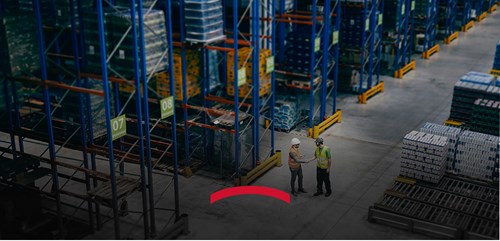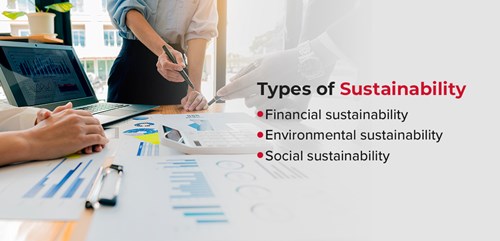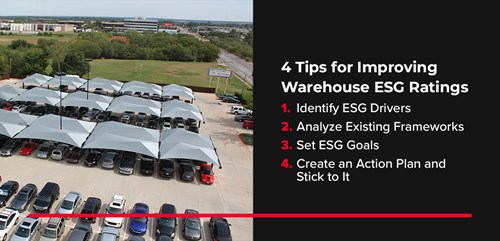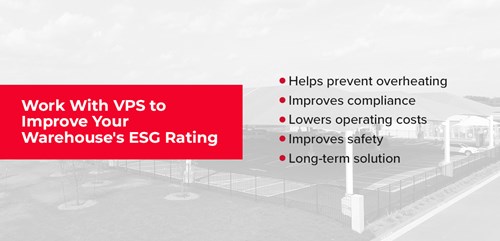Ways to Boost Your ESG Score at Your Warehouse
05.02.23

Environmental, social, and governance (ESG) certification is becoming increasingly essential for all industries. Today, investors and clients are more aware of how their choices affect the environment and society. This growing awareness has impacted how they make business decisions, with many looking to partner with companies that share the same values as them and demonstrate a commitment to long-term financial, environmental and social sustainability.
ESG for warehouses is also essential. Warehouse managers and owners need to be aware of how ESG ratings affect their businesses and what they can do to improve their scoring. Before starting to improve warehouse ESG scores, it is essential to understand existing ESG initiatives and ratings.
Read the full article or jump to a specific section:
- ESG Ratings and Sustainability
- Types of Sustainability
- 4 Tips for Improving Warehouse ESG Ratings
- Benefits of Improving ESG Rating for Warehouse
- Work with VPS to Improve Your Warehouse's ESG Rating
ESG Ratings and Sustainability
ESG is a framework businesses use to assess their impact on society and the environment. There are three main criteria for ESG.
- Environmental: The focus is on the number of resources a company uses, how sustainable its production processes are, and how much pollution it releases.
- Social: This section focuses on how diverse a company is, what causes it supports, and how it impacts the community around them.
- Governance: This refers to how a company is run and the internal systems used to meet the needs of all stakeholders, from investors to employees.
All three criteria highlight businesses' impacts on the community and environment around them. While ESG is divided into three sections, those sections are often intertwined and evaluated accordingly. A business's ESG initiatives and processes are assessed to create an ESG rating or score. The better the score, the more positive a company’s impact is on society and the environment.
ESG ratings are becoming increasingly important for any business, including warehousing, as consumers and investors turn to ESG ratings to determine whether they'll invest in or partner with a company. However, there isn’t a standard for ESG ratings and scores. Different rating companies often use various methodologies, assessments, and scoring systems. Some scoring systems may use A to C, 1 to 100, or poor to excellent gradings.

Types of Sustainability
Sustainability is a significant part of ESG and is mainly related to the environmental and social responsibility criteria. Governance can be indirectly linked, as the internal systems that dictate transparency and accountability can impact sustainability. Sustainability is crucial because it can indicate a business's longevity based on its ability to sustain itself and its commitment to the environment.
Sustainability can be further broken down into three types — financial, environmental, and social. Every kind of sustainability is integral to a company's longevity. Here's a breakdown of the three types of sustainability.
- Financial sustainability: This is one of the most important types of sustainability, as it's vital to longevity. A company needs to have a steady revenue that can satisfy all stakeholders, from investors to employees, and still have sufficient funds to continue investing in the company's growth.
- Environmental sustainability: Finding sustainable ways to produce, store, and transport products is essential to protecting the environment and ensuring the longevity of a company. An environmentally sustainable supply chain can be a powerful tool for companies that want to reduce their carbon footprint.
- Social sustainability: There's a growing focus on human rights throughout the supply chain. Many consumers and investors want to engage with companies that have responsible labor practices. A socially sustainable supply chain can help businesses make the most ethical choices regarding labor.
Overall, ESG is vital to a company's endurance, as it focuses on building relationships between a company, the environment, governments, and various stakeholders, including employees and owners. Developing and maintaining healthy relationships to enhance your ESG can help companies succeed far into the future.
Investors may also use ESG ratings to assess the performance and potential of a company. Higher ESG scores indicate that a company can anticipate risks and opportunities and focus on long-term business development.

4 Tips for Improving Warehouse ESG Ratings
ESG ratings are critical for any warehousing and supply chain business, as they can dictate how investors, consumers, and other stakeholders view a company. Here are four ways to improve warehouse ESG ratings, from identifying ESG drivers to developing an action plan and sticking to it.
1. Identify ESG Drivers
Building a powerful ESG strategy requires ESG drivers. Which aspects of the business can drive ESG? Each criterion has different elements that can be considered when identifying ESG drivers. Some examples for each criterion include:
- Environmental: Waste production, carbon emissions, water and energy usage, and energy sources.
- Social: Charitable donations, community improvement initiatives, and community engagement.
- Governance: Inclusive hiring practices, a good company culture, and vetting suppliers to ensure a proper supply chain.
Identifying ESG drivers for a company will help shape and guide the development of a proper ESG strategy. Having clearly defined drivers ensure warehouse teams focus on key areas to ensure the company remains on target.
2. Analyze Existing Frameworks
Another vital step in improving ESG for warehouses is understanding the existing frameworks, internal systems, processes and their impact on the various criteria. All stakeholders, from warehouse managers to executives, must evaluate the company's current ESG score and relevant procedures. Getting an external ESG rating company to provide this service may be a good idea to ensure an accurate and unbiased analysis of the warehouse's ESG initiatives.
If an ESG framework is already in place, regular assessments can identify strategies that are working and pain points that may need additional resources. Alternatively, this will be the first step in understanding what the company needs to achieve to improve ESG scores. Focus on identifying pain points that can be leveraged to provide significant ESG gains.
Every ESG driver, from total carbon emissions to the hiring process and social responsibility programs, must be evaluated during this evaluation. Some drivers, such as company culture, may be more challenging to quantify than others, so the process may take time. However, it's vital to have a performance baseline to measure future success and progress.
3. Set ESG Goals
Goals ensure all stakeholders know precisely what each department needs and what the ESG strategy aims to achieve. Base the objectives on the evaluation of the key ESG drivers. They can also be linked to other external regulatory factors and pressures, including Net Zero goals and local environmental laws.
It's also important to set achievable goals. Setting massive goals can seem tempting but may be unachievable depending on the resources available, including finances. For example, aiming for zero carbon emissions in the next three years is admirable but can be challenging for most warehouses.
Failing to meet goals can impact morale as stakeholders work diligently to achieve specific goals. It can also damage a company's reputation, especially concerning environmental goals. Committing to an important goal but under-delivering may be seen as greenwashing, which can negatively impact a business's reputation.
An excellent way to approach goals is by separating them into phases. Creating short-, medium-, and long-term goals can help warehouses stay on track by evaluating progress and signaling when specific drivers need additional attention. A phased approach to achieving ESG goals ensures resources and employee time are utilized effectively.
4. Create an Action Plan and Stick to It
Develop an action plan based on the ESG drivers and data from the initial analysis, and stick to it as much as possible. Be specific and lay out everything that needs to be done to meet your ESG goals. Break down every ESG goal into a series of steps and smaller goals. The action plan should include everything from replacing old lightbulbs with energy-efficient lightbulbs to how hiring practices will be changed.
Assign a team or person to be responsible for each step to ensure everyone knows exactly what they need to do. A precise understanding of all the steps and deadlines helps ensure everything is accounted for and tracked correctly. Allow time for regular meetings where teams can discuss their progress, challenges they've experienced, and their next steps.
Use the action plan to prioritize goals. Start with small, low-cost, and low-effort initiatives to help boost employee morale and confidence in the initiatives. These “easy wins” can create momentum and instill teams with the confidence needed to tackle larger ESG goals.
Benefits of Improving ESG Rating for Warehouses
There are several benefits to improving warehouse ESG ratings. Doing so can help warehousing companies enhance their reputations, increase competitive value, attract investors, reduce legal and regulatory interventions, and attract new talent. Here are some of the benefits of ESG improvements for warehouses.
- Improves reputation and image: Consumers are likelier to engage with and partner with companies with a good reputation and image. Focusing on ESG improvements for warehouses can show clients and consumers that companies are environmentally and socially conscious. These shared values can help develop trust, boost credibility, and improve brand awareness.
- Increases competitive value: Shareholders want to invest in companies that are adaptable and proactive and identify opportunities in rapidly changing socioeconomic conditions. As ESG focuses on longevity and sustainability, improving ESG ratings can go a long way to showcasing how a company is actively working to ensure long-term success.
- Attracts new talent: Company culture is becoming more important across the workforce. Employees want to work for companies that treat them well, are inclusive, and match their values. An effective ESG strategy can help attract quality talent and boost loyalty among existing employees. It can also help improve employee productivity, especially when improving the governance aspect of ESG.
- Reduces legal and regulatory interventions: Pressure from legal and regulatory policies can significantly impact warehousing operations. Some effects can include fines for non-compliance, considerable paperwork, and remediation programs. A comprehensive ESG strategy can help warehouses remain compliant, streamline paperwork processes, and reduce the need for remediation programs, which can free up time and resources for other aspects of the business.
- Attracts investors: Investors want quality, long-lasting investments that withstand evolving social and economic conditions. A strong ESG rating is crucial for attracting investors, as it demonstrates a company proactively seeks ways to improve operations to improve sustainability and longevity. Establishing an active, forward-thinking strategy is especially important to investors seeking long-term investors that can span decades rather than a few years.

Work With VPS to Improve Your Warehouse's ESG Rating
There are numerous ways distribution centers and warehouses can improve their EG ratings. VPS offers commercial shade and solar panel parking structures that benefit businesses by helping them work toward better ESG ratings. These protective structures help protect employees, vehicles, and inventory as they're transported between trucks and warehouses. They can also help reduce employee workplace injuries and limit inventory damage.
Here are some of the benefits of installing VPS protective and solar-covered structures:
- Helps prevent overheating: Trailers and trucks can reach dangerously high temperatures when waiting in the sun. These high temperatures can increase the risk of injuries and inventory damage. VPS protective structures can help prevent overheating and reduce the potential for injuries. Lower temperatures can also help minimize a facility's heat island effect, limiting the risk of a dangerous temperature rise.
- Improves compliance: Solar-covered protective structures can help companies achieve compliance with local and federal energy and solar initiatives. They can also assist with complying with safety regulations and requirements.
- Lowers operating costs: Solar-covered protective structures can help reduce costs in a few ways. New structures with solar panels are eligible for local and state tax initiatives that offer tax credits or reductions in response to renewable energy initiatives. Depending on the size of the structures and the number of solar panels, solar-covered structures can help significantly cut energy costs.
- Improves safety: Protective coverings can help protect employees and inventory from harsh conditions, such as high temperatures, snow, and hail. This additional protection can help limit workplace accidents and damaged stock that must be written off, helping make a facility safer and more efficient. Less damaged stock can also help reduce operational costs.
- Long-term solution: VPS solar-covered solutions are long-term solutions for parking areas, loading bays, walkways, and other areas that require protective coverings. They're durable and robust, designed to handle severe weather conditions for many years, including harsh sunlight.
VPS solar-covered shade and protective structures can help improve a warehouse’s ESG score, demonstrating a company's commitment to proactively managing risk and sustainable energy practices.
Choose VPS Solar-Covered Protective Structures
VPS specializes in providing industry-leading protective structures. For over 30 years, countless businesses have trusted VPS to protect their facilities and employees. We work closely with our clients to design, build, and install custom solutions that can benefit warehouses in numerous ways.
VPS provides turnkey solutions, and we control the whole lifecycle of a project, from feasibility studies to permitting to construction. Our collaborative approach makes sure we develop a solution that meets your unique ESG needs. Let VPS help make improving ESG ratings easier. Contact our experienced team today to get started.
